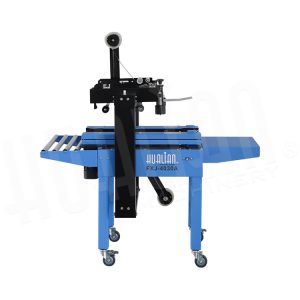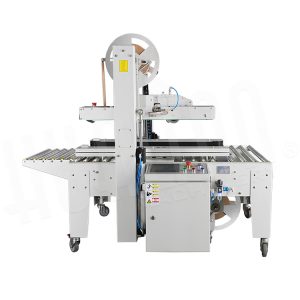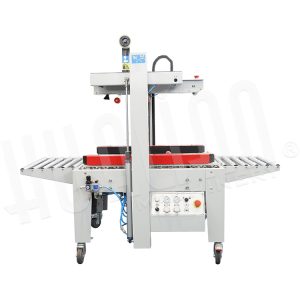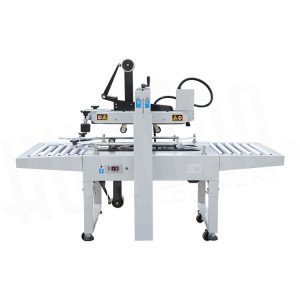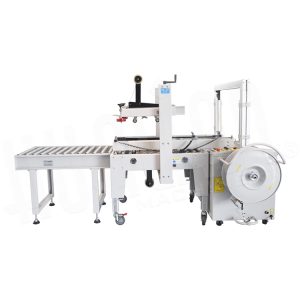Vacuum packaging machines are playing an increasingly important role in food preservation, storage, and distribution. This guide will give you a comprehensive understanding of the features and applications of this type of equipment. After reading it, you will have a deeper understanding of vacuum packaging machines and be able to choose the right product for your needs with confidence.
Table of Contents
ToggleWhat is a Vacuum Packing Machine?
A vacuum packaging machine, also known as a vacuum sealer or vacuum packaging equipment, is a device designed to remove air from a packaging container or bag and then seal it tightly. In this process, it helps to prevent the growth of bacteria, mold, and other microorganisms that lead to corruption.

Discover Hualian Vacuum Sealer!
Key Components of a Vacuum Packing Machine
To understand the working principle of vacuum packaging machine, it is essential to be familiar with its key components:
1 Vacuum Pump
The vacuum pump is the core of any vacuum packaging machine, and it is responsible for drawing out the air from the packaging chamber or bag. Its efficiency and power determine the speed and thoroughness of the air being drawn out.
2 Sealing Bar
After the air is drawn out, the sealing bar applies heat and pressure to the opening of the bag or container to form a tight seal. The length and width of the sealing bar vary depending on the machine’s size and intended use. At the same time, the temperature and pressure applied when using it is carefully controlled to ensure that the seal is firm and the packaging material is not damaged.
3 Control Panel
The control panel is used by users to operate and adjust the settings of the vacuum packaging machine, enabling precise control of the packaging process. It usually includes a button, a knob, or a digital interface for setting parameters such as vacuum time, sealing time, and temperature.
4 Chamber
In the chamber vacuum sealing machine, the chamber is a closed space for the packaging process. Put the product in the bag into the chamber, close the lid to create a sealed environment. Then the vacuum pump will draw air out of the entire chamber, and then the sealing bar is activated to seal the bag.
The Vacuum Sealing Process
The vacuum sealing process includes the following consecutive steps:
1 Bag Placement
First, place the product to be packaged in the appropriate vacuum bag, then place the opening end of the bag in the machine (this step varies depending on the machine), ensure the bag is properly aligned to prevent air from being trapped and ensure a good seal.
2 Air Evacuation
After the bag is placed, the vacuum pump works to lower the internal pressure and effectively suction out most of the air.
3 Heat Sealing
After reaching the required vacuum, the sealing bar will apply heat to the opening of the bag, melt the plastic together, and form a strong seal.
4 Air Release
After the sealing is completed, the machine releases the vacuum in the chamber, and the vacuum sealing is completed. The user can open the machine and take out the sealed package, which is ready for storage or delivery.
How Does a Vacuum Sealer Work?
At a basic level, vacuum packaging machines work by extracting the air from the packaging bag and quickly sealing it. This reduces oxygen exposure and slows down food spoilage. Different types of machines may vary in their operating methods, such as external extraction and internal extraction designs, but the core concept is to achieve preservation by reducing the air pressure inside the bag.
If you would like to learn more about the mechanical structure and technical details involved, please refer to our previous blog post: How Do Vacuum Packaging Machine Work?
Benefits of Vacuum Packing
The advantages of using vacuum packaging machines are numerous, from extending the shelf life of food by preventing spoilage to reducing food waste, it has significant benefits.To learn more about all the benefits, please refer to our previous blog 6 Benefits of Vacuum Packaging You Should Know.
Types of Vacuum Packing Machines
There are many types of vacuum packaging machines, and each type can meet specific needs and applications:
External Vacuum Sealers
The external vacuum sealer, also known as the suction type vacuum sealer, is compact in structure and suitable for home use or small-scale operation. They work by clamping the open end of the bag outside the machine and drawing air out through a port.
Chamber Vacuum Sealers
The chamber vacuum sealing is more durable and efficient, and is very suitable for commercial and industrial use. They have a sealed chamber, in which the entire bag is placed during packaging, so that a more complete vacuum can be achieved.
1 Single Chamber Vacuum Sealer
The single chamber vacuum sealing has one chamber, suitable for small and medium-sized operations. It has good vacuum performance and is general enough to handle various products.

2 Double Chamber Vacuum Sealer
The double chamber vacuum sealing has two chambers. This design can be operated continuously, which is very suitable for high-production environments, such as large food processing plants and commercial kitchens.

3 Table Top Vacuum Sealer
The table top vacuum sealer is a compact chamber model designed to be placed on a table or desk, which is more space-saving and suitable for small commercial operations or laboratories.

4 Vertical Vacuum Sealer
The vertical vacuum sealing machine, also known as the vertical chamber vacuum sealing machine, adopts a vertical design to save floor space. The bag is hung vertically in the chamber, which can effectively prevent spills during the packaging process, making it very suitable for packaging liquids, marinades, and other items.

5 Continuous Vacuum Sealing Machine
The continuous vacuum sealing machine is an industrial-grade device designed for high-volume, continuous packaging. They have a conveyor belt that transports bags through the vacuum and sealing process, allowing uninterrupted operation and the ability to handle large quantities of products quickly and efficiently.

Upgrade to Continuous Vacuum Packaging Today!
Applications of Vacuum Packing Machines
Vacuum packaging machines are widely used in various industries, especially in the food industry:
Meat Packaging
Using vacuum packaging can help maintain the freshness of meat and extend its shelf life. Meat under vacuum sealing can maintain its color, flavor, and texture, and commercial chamber vacuum sealers are often used in meat processing plants and butcher shops.

Seafood Packaging
Seafood is very prone to spoilage, and vacuum packaging is crucial to maintaining its quality. Vacuum packaging can slow down oxidation and bacterial growth, so that the seafood can stay fresh for a longer time.

Sausage Packaging
Sausage is the most commonly used food that is vacuum-sealed. Vacuum packaging helps to keep the sausage moist and in shape, preventing it from drying out.

Vegetable Packaging
Vacuum packaging helps to maintain the moisture, nutrition, and crispness of vegetables. By drawing out the air, the ripening process is slowed down, and the shelf life of vegetables is extended.

Grain, Bean & Legume Packaging
Grains and legumes are easily damaged by pests, and vacuum packaging forms a barrier to protect them from these threats, ensuring their quality and freshness.

Cheese Packaging
If cheese is exposed to air, it may lose its flavor and texture. Vacuum packaging helps to maintain the taste of cheese and prevent mold growth.

Fruit Packaging
Fruits, especially those that have been cut open, tend to oxidize quickly. Vacuum packaging will slow down this process, keeping the fruit fresh and preventing oxidation.

Key Features to Consider When Buying a Vacuum Packing Machine
When purchasing a vacuum packaging machine, consider the following key features to ensure it meets your specific needs:
| Feature | Key Point |
|---|---|
| Vacuum Pressure / Pump | Higher pressure = better preservation; medium for small batches. |
| Seal Bar | Longer/wider bars for larger bags and stronger seals. |
| Material | Stainless steel ensures durability and hygiene. |
| Ease of Use | Simple controls and easy-to-clean parts. |
| Control Options | Manual or automatic with programmable settings. |
| Bag Compatibility | Match machine with bag type, material, and size. |
| Maintenance | Easy upkeep ensures long-term reliability. |
| Noise Level | Consider for small or quiet environments. |
| Safety | Overload protection and emergency stops. |
| Size & Footprint | Ensure machine fits workspace and chamber space. |
| Power Consumption | Energy-saving models reduce costs. |
Vacuum Pressure/Pump Strength
The vacuum pressure or pump power determines how quickly and thoroughly the machine can extract air from the packaging bag. Higher vacuum pressure can extend the shelf life of food and reduce the risk of freezer burn. If you mainly handle perishable foods or products that need to be stored for long periods of time, choosing a model with stronger pump power would be more suitable. For small batches and daily use, a machine with medium vacuum pressure is sufficient to meet your needs.
Seal Bar Length and Width
The length of the sealing bar determines the maximum width of the bag that can be sealed, and the width affects the strength of the seal. If you often package large items, you will need longer and wider sealing bar.
Material and Construction
The material and construction of a machine will affect its durability and performance. It is recommended to choose vacuum packaging machines with high-quality materials (such as stainless steel) as a priority, as these materials are corrosion-resistant and easy to clean. In the food processing industry, where strict hygiene standards are required, this feature is a core element of product safety and quality.
Ease of Use and Cleaning
A user-friendly machine with intuitive control makes operation easier, especially for employees with limited training. In addition, ease of cleaning is crucial for maintaining hygiene standards, and machines with removable parts and smooth surfaces are easier to clean and disinfect.
Control Options
The basic model of vacuum packaging machine usually adopts manual operation mode, while the intelligent automatic model is equipped with advanced configurations such as programmable control system. When choosing, you can flexibly customize personalized packaging solutions for different products.
Bag Compatibility
Ensure that the machine is compatible with the type of vacuum bag you intend to use, and choose the most suitable bag material or size before confirming.
Maintenance and Durability
Look for machines that are easy to maintain and known for their durability, a durable machine will provide long-term reliability and reduce downtime.
Noise Level
The noise level of the machine is a factor to consider, especially in environments where noise is a concern, such as small kitchens or offices.
Safety Features
Safety is crucial when operating any machinery. Look for machines with features such as overload protection, heat-resistant handles, and emergency stop buttons to ensure safe operation.
Size and Footprint
When choosing a vacuum packing machine, make sure its size and footprint fit the space where it will be used. Consider the overall dimensions, chamber size, and the room needed for operation and maintenance. Selecting a machine that fits well ensures efficient workflow and prevents overcrowding in your workspace.
Power Consumption
The power consumption of the machine will affect the operating cost, and energy-saving models can help reduce electricity bills, especially for machines used continuously in industrial environments.
How to Use and Maintain Your Vacuum Sealer?
Usage Tips
·Read the manufacturer’s instructions carefully before using the machine and become familiar with its operation and safety guidelines.
·Ensure that the vacuum bag is compatible with the machine and of good quality to prevent leakage.
·For food products, ensure that they are clean and dry before packaging to avoid contamination and ensure a good seal.
·Leave enough space at the top of the bag for proper sealing. Over-filling the bag will impede a tight seal.
·For liquids, partially freeze them or use a chamber vacuum sealer before vacuum sealing to avoid spills during the process.
·Adjust the vacuum and sealing settings according to the type of product to be packaged. Different products may require different levels of vacuum and sealing time.
Maintenance Tips
·Clean the machine regularly after use. Wipe the seal bar, chamber, and other surfaces with a damp cloth to remove any food residue.
·Lubricate the moving parts according to the manufacturer’s recommendations to ensure smooth operation.
·Check if there is any damage or wear on the sealing bar. If the seal is not strong, it may need to be replaced or adjusted.
·Check if the vacuum pump has any signs of leakage or malfunction. If you notice a decrease in vacuum performance, have a professional inspect the pump.
·When not in use, store the machine in a clean and dry place to prevent dust accumulation.
Choosing the Best Hualian Vacuum Packing Machine
As a well-known vacuum packaging machine manufacturer, Hualian has a rich product model, which can provide you with various machines that meet your needs. According to the needs of different packaging quantities, product types and space conditions, as well as the specifications such as vacuum pressure, sealing strip length and power consumption of the machine itself when purchasing, to ensure that it meets the needs.
Conclusion
Vacuum packaging machines have completely changed the way we preserve and package products, providing numerous benefits in terms of freshness, shelf life, and storage efficiency. From small household desktop vacuum sealers to large industrial vacuum packaging machines for mass production, Hualian has a wide range of options to meet various needs.















